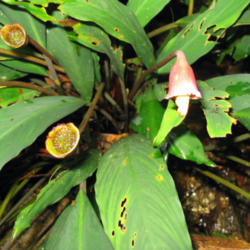| [ Spotted Bee Balm (Monarda punctata var. arkansana) | Posted on May 3, 2015 ] Can grow as an Annual, Biennial or Perennial. |
| [ Spotted Beebalm (Monarda punctata var. punctata) | Posted on May 3, 2015 ] Can grow as an Annual, Biennial or Perennial. |
| [ Mountain Bluet (Centaurea montana 'Amethyst in Snow') | Posted on April 15, 2015 ] Both the bloom and foliage are attractive near the front border, however in my area C. montana starts looking a bit ratty by mid summer, with much of the foliage dying back. Cutting it back seems to encourage new growth. It does better in full sun than part sun with no special care. They're in sandy loam soil. |
| [ Giant Japanese Butterbur (Petasites japonicus subsp. giganteus 'Nishiki-buki') | Posted on April 11, 2015 ] While the blooms aren't precisely showy, I wouldn't describe them as inconspicuous, at least here in my zone. This year and last the blooms have been some of the first green to emerge, and they definitely attract attention. The leaves are obviously the main attraction, so I'm hoping my clump has more big leaves this year. They should play nicely with a few Elephant Ears. I haven't noticed any rampant spreading yet, but the plant is definitely vigorous. I'm growing it in part sun/shade with plenty of water. |
| [ Voodoo Plant (Amorphophallus pendulus) | Posted on April 10, 2015 ] Clone(s) in cultivation in the past are said to be very difficult to keep alive even by highly experienced Amorphophallus growers. An acidic, sandy, sharply draining soil is recommended but even then plants seem to last only for a few years. This is a tropical species endemic to Borneo with leaflets that mature to green with white primary veins. |
| [ Natal Lily (Clivia miniata '4Tune') | Posted on March 31, 2015 ] Tetraploid resulting from colchicine treatment, sibling of Natal Lily (Clivia miniata '4Midable') |
| [ Natal Lily (Clivia miniata '4Midable') | Posted on March 31, 2015 ] Tetraploid resulting from colchicine treatment, sibling of Natal Lily (Clivia miniata '4Tune') |
| [ Dwarf Caladium (Caladium humboldtii 'Marcel') | Posted on March 19, 2015 ] A sport of Dwarf Caladium (Caladium humboldtii) , 'Marcel' was discovered by Marcel Lecoufle in a batch of tissue cultured plants. According to Lecoufle, C. humboldtii had not been known to flower either in the wild or in cultivation. 'Marcel' is nearly pure white with thin green veining, unlike the species, which is dark green with white splotches. Like the species, the smallest in the genus, it typically grows 6 to 7 inches tall, although occasionally taller. |
| [ Fancy-leaf Caladium (Caladium 'Candidum Senior') | Posted on March 6, 2015 ] Per the breeder, this is a larger and more vigorous selection of Dwarf Fancy-leaf Caladium (Caladium 'Candidum Junior') . |
| [ Fancy-leaf Caladium (Caladium 'Party Punch') | Posted on February 28, 2015 ] Sibling of Fancy-leaf Caladium (Caladium 'Bombshell') |
| [ Fancy-leaf Caladium (Caladium 'Bombshell') | Posted on February 28, 2015 ] Sibling of Fancy-leaf Caladium (Caladium 'Party Punch') |
| [ Thaumatophyllum xanadu | Posted on February 24, 2015 ] Initially patented in Australia, and then in the USA, PP7,030 (1989) as Philodendron Selloum 'Winterbourn' and given the trade name Xanadu™. This Philodendron was discovered to have been in cultivation significantly longer than initially believed. |
| [ Sedeveria (XSedeveria 'Hummellii') | Posted on February 22, 2015 ] This is the plant described by Eric Walther in 1953; SEDEVERIA A New Bigeneric Hybrid, Cactus and Succulent Journal, 25: 20. 1953. Since then new cultivars of x Sedeveria have been bred from a variety of Echeveria and Sedum species and cultivars. |
| [ Flamingo Flower (Anthurium 'Pink Paradise') | Posted on February 21, 2015 ] This bi-colored hybrid Anthurium is a product of Rijn Plants in the Netherlands. Not to be confused with the much earlier introduction, Flamingo Flower (Anthurium 'Paradise Pink') |
| [ Flamingo Flower (Anthurium 'Paradise Pink') | Posted on February 21, 2015 ] This University of Florida hybrid was introduced prior to 1984. Not to be confused with Flamingo Flower (Anthurium 'Pink Paradise') patented in 2000. |
| [ Giant Swamp Taro (Cyrtosperma merkusii) | Posted on February 16, 2015 ] Due to its long having been cultivated as a food crop, C. merkusii is the most widespread and variable species in the genus. These cultivated forms have been found growing to nearly 20 feet tall and often lack spines. Wild forms are usually much shorter (3 to 4 feet) and are armored. Typical habitat is freshwater marshes and swamps and at the edges of lakes and rivers. |
| [ Coontie (Zamia integrifolia) | Posted on February 3, 2015 ] If your Coontie is a Florida native, this is your plant. Based upon the current taxonomic scrutiny, as listed by the Catalog of Life, Zamia integrifolia is the accepted name, with Z. floridana (thin-leaf form) and Z. umbrosa (wide-leaf form) listed as synonyms. |
| [ Pothos (Epipremnum aureum 'Golden Pothos') | Posted on January 28, 2015 ] Not to be confused with Pothos (Epipremnum aureum) |
| [ Piptospatha | Posted on January 23, 2015 ] Piptospatha is a genus in family Araceae native to Southeast Asia (Thailand to Borneo). Described as obligate rheophytes, they are only known to grow in running water on rocks. 
Photos of Bornean Piptospatha can be seen here: Araceae of Suna; Piptospatha |
| [ Anthurium pentaphyllum var. bombacifolium | Posted on November 18, 2014 ] This Anthurium is native to Central America from Mexico to Panama. |